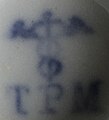Carl Tielsch
Carl Tielsch & Co. was a Silesian porcelain manufacturer .
Manufactory
Carl Robert Tielsch founded the porcelain manufacture Carl Tielsch & Co. in 1845 in Altwasser near Waldenburg in the administrative district of Breslau . Gideon von Wallenberg was a silent partner.
It began in 1845 with three kilns and around 60 employees. The first technical manager was Ernst Bauer. The factory quickly became one of the largest German porcelain manufacturers. In 1851 the factory employed 300, in 1863 already 1,400 and then at times 1,500 workers. The success was based on quality at affordable prices, a wide range of products, which included household porcelain as well as hotel tableware, luxury items and sumptuous tableware. It was also important to have the best developers and painters. The nearby coal mines for the fuel required, as well as the connection of backwater to the railway network in 1853, proved to be a locational advantage.
The manufactory experienced international recognition at trade fairs and exhibitions in London in 1851 and 1862, Paris in 1867, Vienna in 1873 and Melbourne in 1880. a. in London, Athens, Cairo, Tunis, Rio de Janeiro and New York ensured the worldwide distribution of Tielsch porcelain.
The company's social work included the establishment of a workers' and disability fund. Carl Tielsch had decreed in a will that upon his death 30,000 gold marks would be brought into a foundation for the workers.
After the death of the father and company founder Carl Tielsch, his son Egmont von Tielsch took over the management of the company in 1882. Georg Faist had been the technical director since 1897.
At the beginning of the First World War , the product catalog comprised 1637 pieces in up to 196 variations. At that time the manufactory employed 270 potters and 110 painters. Tielsch started first in 1906
Companies in the German porcelain industry with production in tunnel ovens, which replaced the round ovens.
In 1917, the Wroclaw War Office ordered production to be cut to 60 percent. On January 1, 1917, the Egmont von Tielsch family business was incorporated into the stock corporation "Porzellan-Manufaktur C. Tielsch & Co., AG". The AG had some well-known partners such as Georg Faist, the banking house Gebrüder Arnhold and Hugo Auvera (company CM Hutschenreuther ). At the same time, Egmont von Tielsch entered into an interest group with the CM Hutschenreuther porcelain factory in Hohenberg / Bavaria, which took over the majority of the shares on March 29, 1920. After Egmont von Tielsch's death in 1920, Herbert von Tielsch took over the seat on the AG's supervisory board . Until the Great Depression , the company prospered stark.1932 the company Hutschenreuther and Tielsch joined together. The manufactory was then called " Porzellanfabrik C. Tielsch & Co., department of CM Hutschenreuther AG" within the Hutschenreuther group . With the Soviet occupation and the establishment of a Polish government on May 8, 1945, the entire factory was expropriated.
On the instructions of the Soviet administration, part of the factory was first dismantled . Then production was continued with a few Germans who had not been expelled under the name "Polska Fabryka Porcelany Tielsch" until 1952. In 1952 the factory was finally nationalized and under the name Zaklad Porcelany Stolowej "Wałbrzych" it became a main porcelain production facility for Poland.
In 1992 the factory was re-privatized and now 15 percent belongs to the Polish state.
China brands
The porcelain manufactory Carl Tielsch & Co. used various porcelain brands TPM (Tielsch Porcelain Manufactory from 1845 - 1863), and from 1863 various CT porcelain brands.
The Tielsch family
- Carl Tielsch (1815–1882), founder
- Egmont von Tielsch (1854–1920), son of Carl, leader until 1920, reserve officer, awarded the Red Eagle Order IV class , ennobled as Egmont Ritter von Tielsch , royal Prussian councilor of commerce
- Herbert von Tielsch, son of Egmont
The Tielsch Fideikommiss comprised the Reussendorf manor . Until the Second World War, this belonged to the Fürstenstein lordship (a total of 8,700 hectares of forest). In 1925, the forest area (estimate: 1/3 of the total property) comprised 220 hectares. At the end of the Second World War, the Tielsch family had to give up Reussendorf Castle. Now Polish, it was used as an orphanage and school. It is currently empty. There is an outdoor swimming pool on the site of the former palace garden.
literature
- Eitel Tette: Porcelain Manufactory Carl Tielsch-Altwasser. Beautiful and valuable porcelain from Silesia. Volume 1, Husum 1992, ISBN 3-88042-596-5 ; Volume 2, Husum 2002, ISBN 3-89876-006-5 .
- Frank K. Tarikk Riemann: Porcelain from Prussian Silesia. Carl Tielsch, Altwasser. Self-published , Coasts November 2006.
- Frank K. Tarikk Riemann: Porcelain from Prussian Silesia. Carl Tielsch, Altwasser. Self-published , Coasts 2009.
- Gerhard Schmidt-Stein: Silesian porcelain before 1945 . Bergstadtverlag Korn, Würzburg 2007, ISBN 978-3-87057-207-5 .
- Schlesischer Kulturspiegel 41st year 2006, porcelain pleasure. The production of Carl Tielsch from Waldenburg-Altwasser, Stephan Kaiser, Nicola Remig, Gerhard Schmidt-Stein.
Individual evidence
- ↑ Sabine Zehentmeier: Life and Work of Porcelain Manufacturers in Northeast Bavaria (1870-1933) , Hohenberg / Eger 2001 (University of Bamberg, diss.), P. 80.
Web links
- private, extensive collector's website on the subject of the Tielsch-Altwasser porcelain brand and its connoisseurs ; Retrieved December 26, 2015
- Pictures of the company yesterday and today
- The Tielsch Palace in Waldenburg today (Polish)
Coordinates: 50 ° 47 ′ 3.9 ″ N , 16 ° 17 ′ 0.5 ″ E












